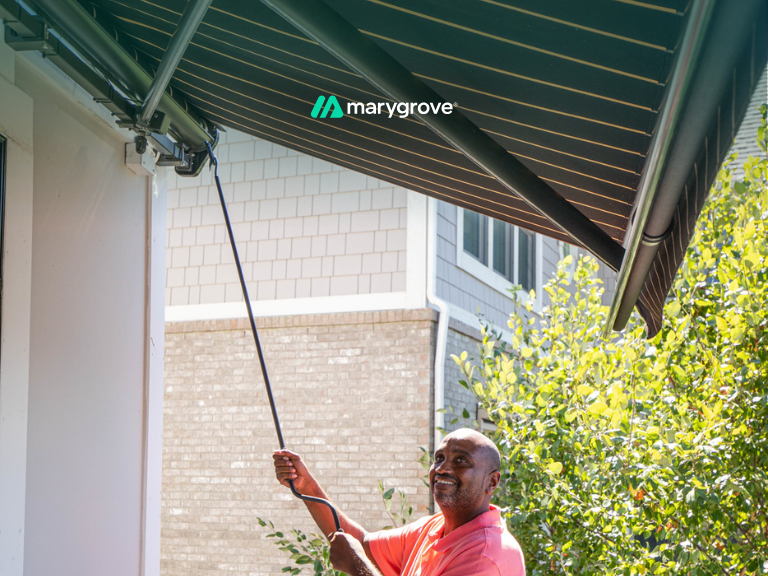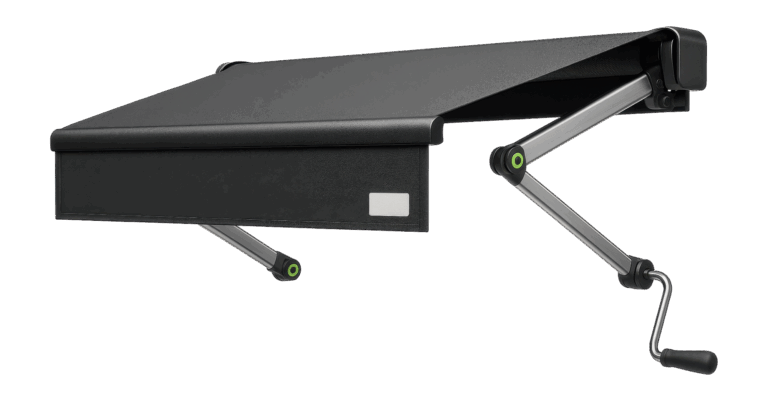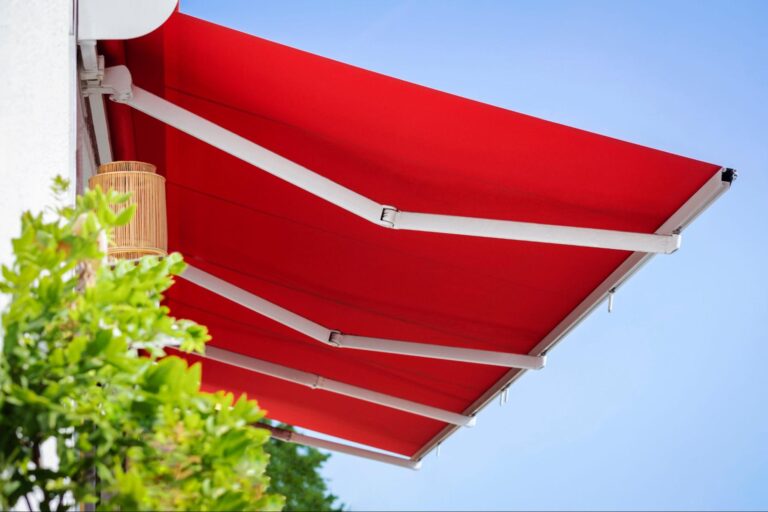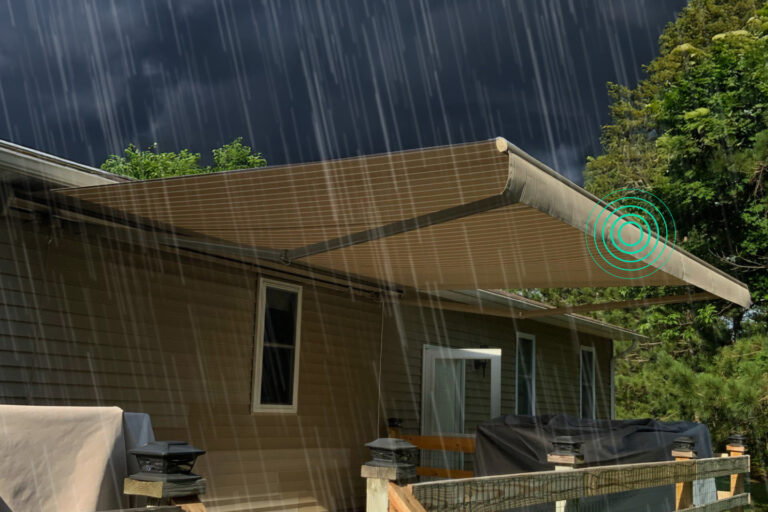Manual retractable awnings are hand-cranked, electricity-free systems that extend and retract fabric shade over patios, decks, or windows using a simple mechanical design and durable support arms.
Manual Retractable Awnings: Simple Shade That Works on Your Terms
Manual retractable awnings provide flexible shade using a crank, no wires, remotes, or power needed. Ideal for simple, reliable coverage on patios, balconies, or seasonal spaces.
Here’s what you should know upfront:
- They’re fully manual: You operate them by turning a crank to extend or retract the awning.
- No wiring required: Great for cabins, sheds, or off-grid setups.
- Lower cost, fewer parts: You save on install and avoid electrical breakdowns.
- Watch the weather: You’ll need to retract them manually in high winds.
- Retrofitting to motorized later is possible but isn’t always simple or cheap.
Whether manual fits your lifestyle depends on who’s using it, where it’s going, and how much you value automation. These systems are easygoing, until they’re not.
Choosing your awning wisely now saves time and hassle later.
And if you’re weighing comfort vs. control, there’s a lot more to consider before making your final decision. Let’s dig in.
Understanding Manual Retractable Awnings: Simplicity That Works

Manual retractable awnings are crank-operated shade systems that work without electricity or apps, ideal for homeowners who prefer simple, low-maintenance awning solutions.
The Mechanics Behind the Simplicity
Manual awnings may be simple, but their design is thoughtfully engineered for ease of use and durability. Here’s how the core components come together:
- Hand Crank Drive: Rotates a gear inside the roller tube, allowing the fabric to smoothly extend or retract.
- Support Arms: Spring-loaded arms keep the fabric taut, ensuring proper tension and shape.
- Fabric Roll: The awning fabric rolls around a central aluminum or steel tube as you crank.
- Mounting Brackets: Secured to strong surfaces like brick or siding, brackets keep the system anchored and safe.
- Optional Vertical Rods: Some models include added supports for better wind resistance and fabric stability.
Together, these parts offer a system that works as well in remote cottages as it does over a suburban patio.
Manual vs. Motorized: Core Functionality at a Glance
How your awning operates directly affects your daily outdoor routine, especially when shade, weather, and convenience are at play.
- Manual Retractable: Operated with a hand crank, manual awnings rely on physical effort to extend and retract. There are no electrical parts, making them reliable during power outages and suitable for homes without outdoor wiring.
- Motorized: Uses a remote, switch, or app to control movement. Some models include wind or sun sensors for automatic adjustment in changing weather.
Manual offers total control, while motorized brings ease; choosing between them depends on your lifestyle and expectations.
Can You Upgrade to Motorized Later?
While some manual models can be retrofitted later, it often requires swapping key components, making it nearly as costly as starting fresh.
So, if smart features are in your future, it’s worth factoring that into your decision now.
Next, let’s look at the pros and cons of manual retractable awnings to help clarify if they truly fit your space and lifestyle.
Helpful Resource → Manual vs Motorized Retractable Awnings
Simple, Strong, or Frustrating? The Honest Pros and Cons of Manual Awnings

Manual retractable awnings offer a back-to-basics approach to outdoor comfort, but they’re not perfect for every space or every user.
Here’s a closer look at where they shine and where they might fall short.
What Works Well
For homeowners who value simplicity and self-sufficiency, manual awnings deliver dependable shade without relying on complex systems.
These strengths make them ideal for certain lifestyles and outdoor setups.
- No electricity required: Great for off-grid homes, cabins, or locations without outdoor wiring.
- Lower upfront cost: More affordable than motorized versions, both in product and installation.
- Fewer failure points: With no motors or electronics, there’s less that can go wrong long-term.
- DIY-friendly: Smaller models can be installed without hiring a professional.
- Quiet operation: No motors means silent, smooth adjustments.
In the right settings, these benefits can make manual awnings a long-lasting, reliable investment with minimal upkeep required.
Where Things Get Tricky
While manual awnings have their place, they come with practical limitations that are important to consider, especially in unpredictable weather or larger outdoor spaces.
- Physical effort needed: Larger units can be tough to crank, especially for seniors or when it’s hot.
- Manual weather response: No built-in sensors, owners must monitor wind and retract in time.
- Tension issues: If arms aren’t properly aligned, fabric may sag or wrinkle over time.
- No automation: Can’t integrate with apps, voice assistants, or smart home routines.
- Wear and tear: Gears may strip or stiffen over time, particularly in lower-cost models.
These drawbacks don’t affect every homeowner equally, but they’re worth weighing carefully before choosing a manual setup.
Next, we’ll look at when manual awnings are the perfect fit, and when they’re not.
Also Read → Fixed vs Retractable Awnings: Pros, Cons & Smart Comparisons
When Manual Retractable Awnings Make Sense (and When They’re a Mistake)

Manual awnings aren’t for everyone, but in the right context, they’re a simple, dependable choice.
This section explores where these awnings work best and where they may fall short based on real-world use.
When They’re a Smart Fit
Manual awnings meet the mark in specific situations where simplicity, cost, and independence matter more than automation.
These use cases are where manual setups truly excel.
1. Secondary Homes And Vacation Cabins
Manual awnings are perfect for seasonal spaces where electricity isn’t always available. Their low-maintenance design suits vacation properties that don’t need full-time smart home integration.
2. Detached Structures Like Sheds Or Greenhouses
These awnings offer shade for structures without power access. Whether it’s a garden shed or workshop, manual systems eliminate the need for trenching wires or adding outlets.
3. Homeowners On A Tight Budget Or Who Prefer Simplicity
With lower upfront costs and fewer components, manual awnings are ideal for buyers who want functional shade without added expense, apps, or tech-based features.
4. Off-Grid Or Low-Tech Lifestyles
For those who value self-reliance or live in rural areas, manual awnings provide dependable protection without depending on electrical grids or internet-connected systems.
In these environments, the advantages of manual operation outweigh the limitations, and the low-tech design becomes a strength, not a drawback.
Helpful Resource → How Much Do Retractable Awnings Cost in 2025? [Full Pricing Guide]
Where People Often Go Wrong

Even simple systems like manual awnings can lead to frustration if misunderstood. These are the most common mistakes buyers make when selecting or using one.
1. Choosing Cheap Fabric = No Uv Or Mold Resistance
Low-quality fabric fades quickly and won’t protect against UV exposure or mildew. It often offers little more than visual coverage without true functionality. High quality awning fabrics are what truly serve a worth shade.
2. Ignoring Pitch Adjustment Needs = Poor Shade Performance
Without adjusting the awning’s angle, you may lose valuable shade during certain times of day. Pitch matters more than many buyers initially realize.
3. Thinking It’s A One-Person Install, It’s Not For Large Units
Large awnings are heavy and require precise alignment. Attempting solo installation can damage components or result in unsafe mounting over time.
4. Leaving It Out In High Winds = Mechanical Failure Risk
Manual awnings don’t auto-retract, so leaving them open during storms can lead to torn fabric, bent arms, or stripped crank gears.
Being aware of these pitfalls early on can prevent disappointment, and help you get the most out of your manual awning for years to come.
Understanding where manual awnings fit, and where they don’t, can help you avoid costly mistakes. But for many, the desire for more ease and protection eventually points to something smarter.
Why Many Homeowners Eventually Switch to Smart or Motorized Awnings

Manual awnings offer simplicity, but many homeowners find themselves wanting more flexibility and less daily effort. That’s when the shift toward smart and motorized options begins to make sense.
- Tap-to-Control Convenience: Motorized awnings open and close with a remote, switch, or smartphone, eliminating the need to crank or manually adjust.
- Smart Weather Protection: Sensors can detect wind or sunlight and automatically retract or extend the awning to protect your space and the system itself.
- Improved Frame and Tension Systems: Upgraded engineering delivers smoother operation and stronger performance, especially for wide-span awnings.
- Cleaner, Built-In Aesthetic: Cassette housings and integrated features create a polished, modern look that complements your home’s exterior.
- Integrated Lighting Options: Built-in LED lighting transforms evening use, adding ambiance without the need for extra fixtures.
- Longer Lifespan with Less Hassle: Fewer manual actions mean less wear over time, extending the awning’s life and lowering maintenance costs.
- A Smarter Shade Spectrum: From basic remotes to voice-activated automation, “smart” varies widely, knowing what you need helps match the right features.
Smart awnings are less about tech for tech’s sake, and more about making your outdoor space work better, every day.
For those seeking more convenience, protection, and long-term ease, smart awnings offer a practical upgrade.
They’re built to adapt, so you don’t have to.
Final Thoughts: Is Manual Right for You, or Is It Time to Upgrade?
Manual awnings make sense for homeowners who value simplicity, want to save on upfront costs, or live in areas where electrical access is limited.
They’re especially practical for cabins, vacation homes, and smaller outdoor spaces.
That said, lifestyle matters. If you want the ease of one-touch control, weather-based automation, or a system that integrates into your smart home setup, motorized awnings may offer better long-term value.
Think about how often you’ll use your awning, who in your home will be operating it, and how much convenience matters in your day-to-day.
Explore Marygrove Awnings
Reach out for a free estimate and discover the right shade solution for your space, built to fit your lifestyle, your home, and how you enjoy the outdoors.

